Imagine adding a slice of nature’s calm to your living room or office. A self-contained aquatic display lets you enjoy flowing streams and vibrant greenery without stepping outside. These compact ecosystems fit perfectly in modern homes, using simple containers like glass bowls or repurposed vases.
You don’t need a green thumb to succeed. When balanced correctly, these miniature worlds maintain themselves. Beneficial bacteria and aquatic plants work together, filtering the environment naturally. Just add light, and watch life flourish with little daily effort.
The benefits go beyond beauty. Studies show water features reduce stress levels by 30% while improving air humidity. Your creation becomes a living art piece that evolves over time – perfect for small apartments or spacious houses alike.
This guide walks through designing systems that thrive. We’ll compare desktop aquarium designs to larger installations, helping you pick what fits your lifestyle. You’ll learn how to combine plants, lighting, and water flow for lasting harmony.
Ready to transform unused corners into eye-catching focal points? Let’s explore how simple materials create stunning results. Your personal oasis awaits – no backyard required.
Embracing the Indoor Aquatic Garden Lifestyle
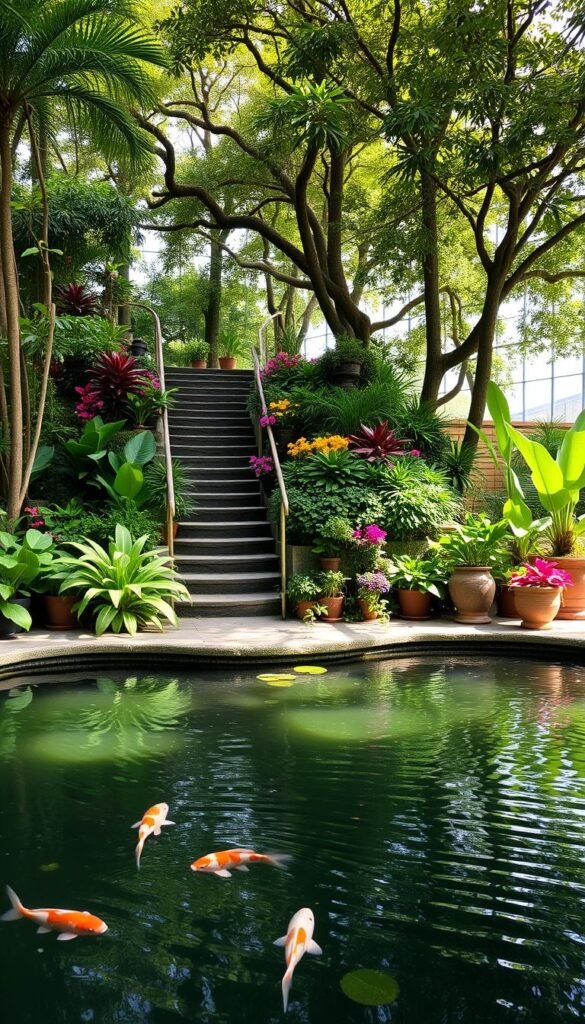
Bringing flowing streams and living greenery into your space does more than refresh your decor – it transforms how you experience daily life. These dynamic displays merge art with ecology, offering sensory rewards that static decorations can’t match.
Wellness Meets Natural Beauty
Moving water and thriving plants work together to boost your well-being. The gentle trickle of a tabletop fountain can lower heart rates, while moisture released by aquatic plants combats dry air from heating systems. Studies show people near water features report 40% less anxiety during stressful tasks.
Crafting Your Effortless Ecosystem
Smart design choices make care simple. Start with these key elements:
| Container Material | Best For | Care Level |
|---|---|---|
| Glass | Small aquarium setups | Weekly cleaning |
| Ceramic | Larger plant displays | Monthly maintenance |
| Resin | Child-safe spaces | Wipe surfaces |
Pair fast-growing species like water lettuce with slow-developing mosses. This balance prevents overcrowding and keeps nutrient levels stable. Your system becomes self-regulating – just refresh evaporated liquid every 10 days.
Selecting the Ideal Space and Essential Equipment
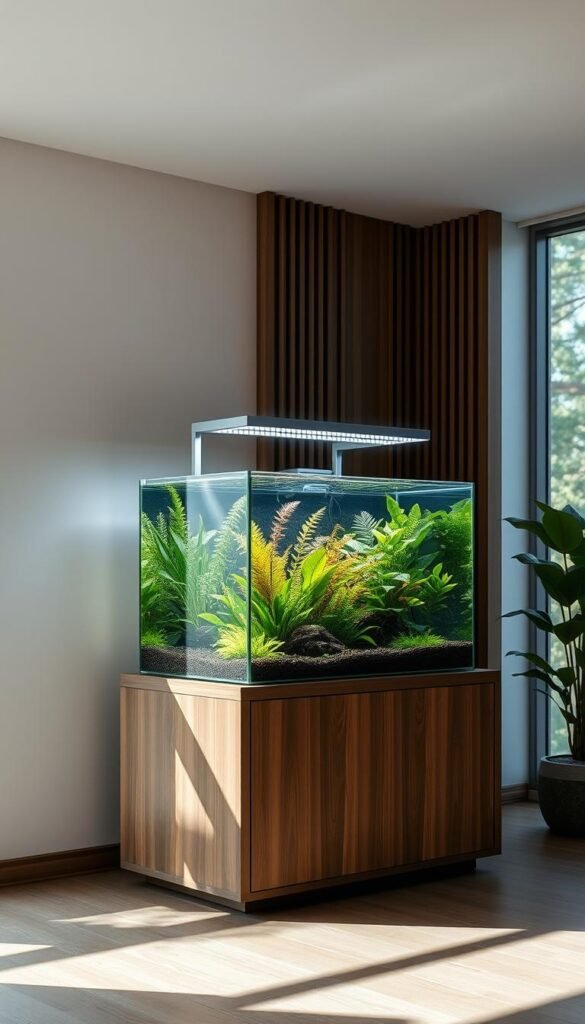
Your home’s layout plays a crucial role in sustaining a thriving miniature ecosystem. Start by identifying areas with bright, indirect sunlight – near east-facing windows works perfectly. These spots provide enough energy for plants without promoting excessive algae growth. Keep containers away from heating vents or drafty doors to maintain stable temperatures.
Choosing the Right Location and Lighting
Modern LED systems revolutionize how we support aquatic life indoors. These energy-efficient solutions deliver full-spectrum illumination while staying cool to the touch. Aim for 2-4 watts per gallon – a 5-gallon aquarium needs 10-20 watts. Timers help maintain consistent daily cycles, mimicking natural environments.
Key Equipment: Filters, Pumps, and Aerators
Three components keep your system healthy:
- Filters: Remove debris and house beneficial bacteria
- Submersible pumps: Create gentle water movement
- Air stones: Boost oxygen levels for roots and fish
Compact equipment suits smaller setups best. A DIY container display might only need a 50 GPH pump. Always check noise ratings – look for models below 40 decibels for peaceful operation. Keep backup air pumps handy for power outages.
| Equipment Type | Small Container | Large Setup |
|---|---|---|
| Filter | Sponge filter | Canister filter |
| Pump | 3W submersible | 10W adjustable |
| Lighting | Clip-on LED | Suspended panel |
Regular maintenance becomes effortless when you match equipment size to your container’s volume. Test water flow weekly – leaves should sway gently, not get battered by currents.
Indoor Water Garden Basics: Setting Up a Low-Maintenance Aquatic Oasis
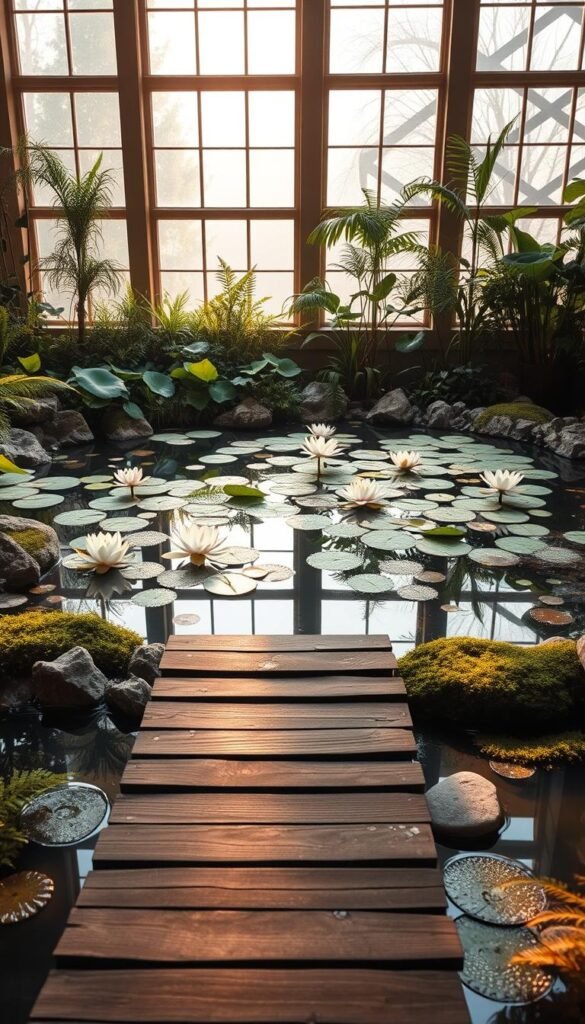
A successful water feature combines visual harmony with consistent water management. Let’s explore how strategic design choices and simple care routines create thriving ecosystems that captivate the eye while staying easy to maintain.
Planning Your Layout and Water Feature
Create depth in small spaces using layered planting. Tall grasses at the back, medium-height plants in the center, and mosses up front trick the eye into seeing more space. This approach works whether you’re using a 3-gallon bowl or a 15-gallon tank.
| Container Size | Foreground Plant | Background Plant |
|---|---|---|
| Under 5 gallons | Dwarf hairgrass | Bamboo stalks |
| 5-10 gallons | Java moss | Water wisteria |
| 10+ gallons | Marimo balls | Umbrella palm |
Managing Water Quality and Maintenance
Always start with fresh water that’s been treated. Let tap water sit uncovered for a day to remove chlorine, or use a dechlorinator for immediate results. Test weekly with strips – aim for pH 6.5-7.5 and stable temperatures between 68-78°F.
Change 25% of the water clean monthly to prevent buildup. If you spot green tint or fuzzy growth, reduce light exposure by 2 hours daily. Add beneficial bacteria supplements during water changes to boost natural filtration.
Quick tips to keep water clean:
- Wipe glass walls during refills
- Trim decaying leaves promptly
- Use a turkey baster for spot cleaning
Choosing and Caring for Aquatic Plants and Fish
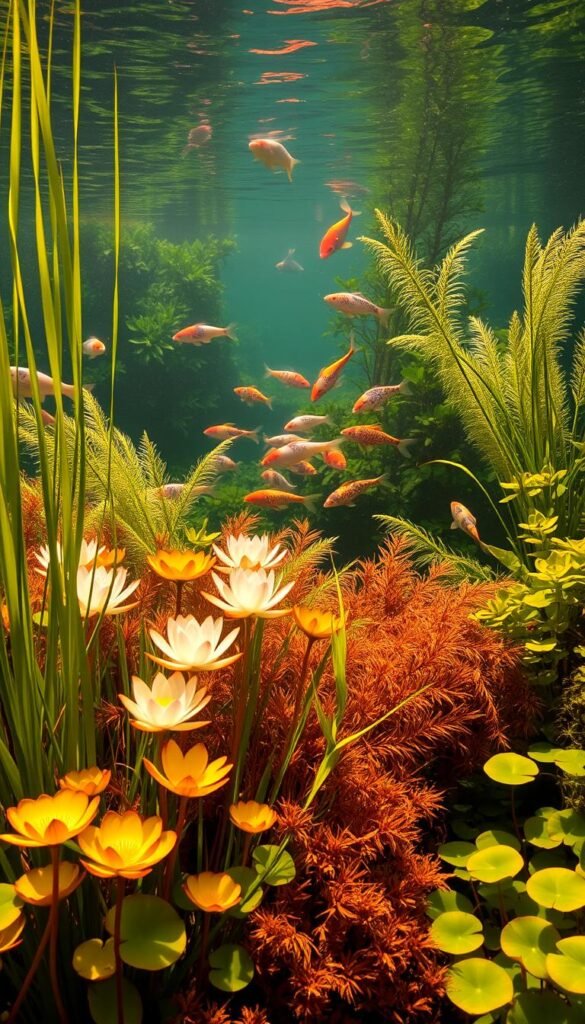
Transform your space into a living masterpiece by pairing vibrant greenery with graceful swimmers. The right combination of aquatic plants and fish creates a dynamic relationship – each element supporting the other’s survival while enhancing visual appeal.
Picking the Perfect Aquatic and Floating Plants
Start with easy-care species that adapt well to containers. Madagascar Lace adds dramatic texture with its skeletal leaves, while Tiger Lotus brings fiery red accents. For surface coverage, water lettuce forms natural filters with its trailing roots.
| Plant Type | Key Benefit | Care Level |
|---|---|---|
| Brazilian Pennywort | Oxygenates water | Low |
| Water Lily | Provides shade | Moderate |
| Java Moss | Hides equipment | Easy |
Anchor rooted varieties in gravel or sand, leaving crowns exposed. Trim yellowing leaves weekly to prevent decay. Use liquid fertilizers sparingly – overfeeding fuels algae growth.
Ensuring a Balanced Ecosystem with Fish
Select fish that match your container’s size and plant life. Goldfish add movement but need ample space – follow the “one inch per square foot” rule. For smaller setups, mosquitofish control pests without overcrowding.
Create synergy between species:
- Fish waste nourishes plants growing in the system
- Plant roots filter ammonia from water
- Floating plants reduce light exposure to deter algae
Feed fish small portions twice daily using aquaponic-grade food. Watch for rapid gill movement or faded colors – these signal water quality issues. Test pH monthly and adjust gradually if needed.
Incorporating Hardscapes and Substrates for a Polished Look
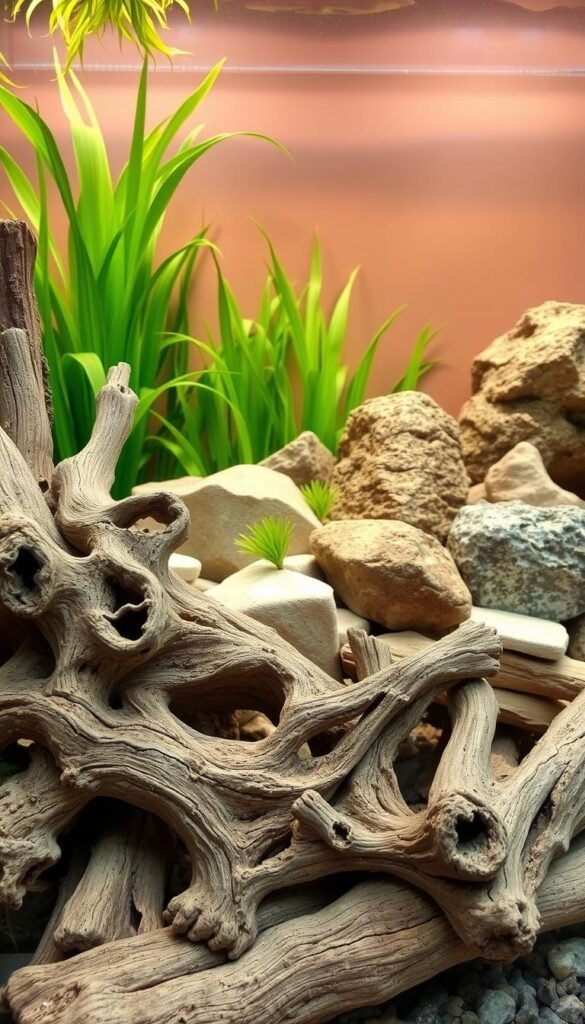
Elevate your design by blending functional materials with artistic arrangements. The right combination of textures and materials turns basic setups into captivating displays that mimic natural habitats.
Using Natural Elements Like Rocks and Gravel
Start with rocks that complement your container’s size. Slate pieces create dramatic cliffs in tall glass tanks, while smooth river stones suit shallow bowls. Use varied sizes – large boulders anchor corners, medium stones build midground interest.
Gravel serves dual purposes. It anchors plant roots and hosts beneficial bacteria. Choose 2-4mm grains for easy cleaning. Dark substrates make green plants pop, while white sand mimics tropical beaches.
| Substrate Type | Best For | Nutrient Support |
|---|---|---|
| Basic Gravel | Beginner setups | Low |
| Volcanic Soil | Rooted plants | High |
| Sand | Bottom dwellers | None |
Creating Attractive Pathways and Visual Focal Points
Apply the rule of thirds when placing rocks. Position your largest stone one-third from the tank’s edge. Slope substrate upward toward the back – this 3-degree tilt adds depth.
Driftwood makes perfect natural bridges. Soak pieces first to prevent floating. Arrange them diagonally across the aquarium, leaving open swimming lanes. Add moss to weathered edges for aged charm.
Maintain balance through contrast. Pair jagged lava rocks with smooth pebbles. Use light-colored gravel to highlight dark stone formations. Rotate elements seasonally for fresh perspectives without full redesigns.
Embracing Your Indoor Oasis Journey
Cultivating your personal aquatic retreat becomes a rewarding journey of discovery. As you tend to your ecosystem, you’ll notice how minor adjustments create big impacts. Weekly debris removal and filter checks become second nature, helping keep water clarity while balancing nutrients.
Watch your confidence grow with each season. You’ll master timing for pruning plants and adjusting light exposure as temperatures shift. Spotting early signs of algae growth transforms from concern to quick problem-solving – a skill that lets your creation thrive for years.
Connect with fellow enthusiasts to exchange ideas and celebrate milestones. Share tank redesign photos or pond filter upgrades that boosted water quality. These connections deepen your understanding while inspiring new projects.
Your living display offers daily rewards beyond aesthetics. Observe fish darting through swaying plants after work, or enjoy morning coffee beside gentle ripples. This ever-changing sanctuary becomes part of your home’s heartbeat – a testament to patience and care.






